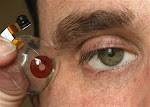 Ultraviolet image of the sun. The intensity of the sun's million-mile-per-hour solar wind has dropped to its lowest levels since accurate records began half a century ago, scientists say.
Ultraviolet image of the sun. The intensity of the sun's million-mile-per-hour solar wind has dropped to its lowest levels since accurate records began half a century ago, scientists say.The intensity of the sun's million-mile-per-hour solar wind has dropped to its lowest levels since accurate records began half a century ago, scientists say. Measurements of the cosmic blasts of radiation, ejected from the sun's upper atmosphere, were made with the Ulysses spacecraft, a joint mission between NASA and the European Space Agency (ESA).The solar wind "inflates a protective bubble, or heliosphere, around the solar system," which protects the inner planets against the radiation from other stars, said Dave McComas, Ulysses' solar wind principal investigator and senior executive director at the Southwest Research Institute in San Antonio, Texas."With the solar wind at an all-time low, there is an excellent chance the heliosphere will diminish in size and strength," said Ed Smith, NASA's Ulysses project scientist at the Jet Propulsion Laboratory in Pasadena, California."If that occurs, more galactic cosmic rays will make it into the inner part of our solar system," added Smith.Scientists say the weakening of solar wind appears to be due to changes in the sun's magnetic field, but the causes of these changes are unknown.The weakened solar activity can be beneficial because it slows satellites around the Earth, allowing them to remain in orbit longer.The sun normally experiences 11-year-cycles between periods of great activity and lesser activity.But, Smith said, the Ulysses mission's recent results, published in Geophysical Research Letters, show that "we are in a period of minimal activity that has stretched on longer than anyone anticipated."The Ulysses mission was the first project to survey the space environment over the sun's poles. The data the spacecraft has collected has profoundly changed the way scientists view our nearest star and its effects on the Earth.The spacecraft has traveled more than 539 million kilometers in more than 18 years, almost four times its expected lifetime.
http://www.breitbart.com/article.php?id=080924193222.3r9aw25a&show_article=1
http://www.breitbart.com/article.php?id=080924193222.3r9aw25a&show_article=1
As in the days of Noah....






















































































.bmp)

























.bmp)